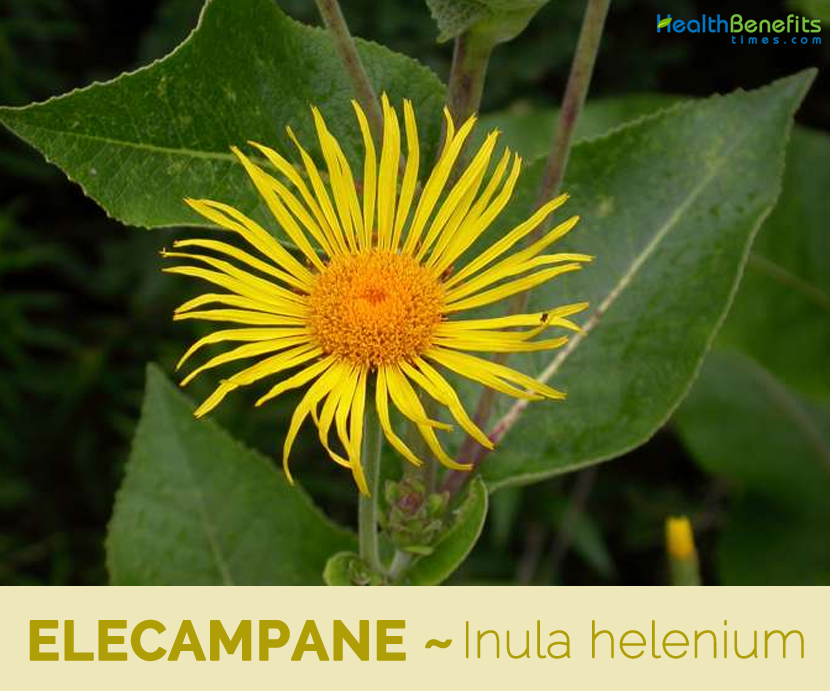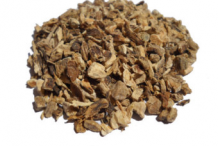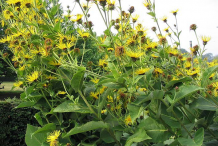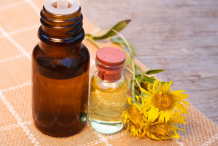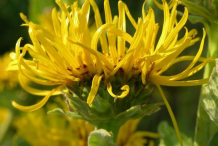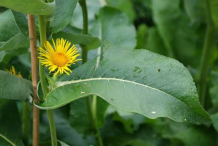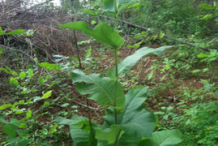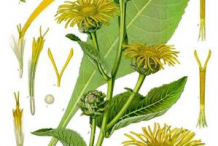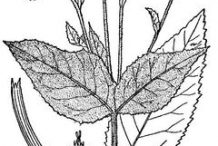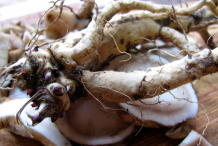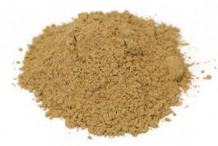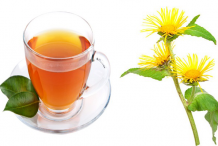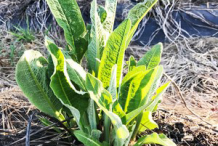Plant Description
Elecampane is a tall, bristly perennial composite plant that grows about 3 meters tall. The plant is found growing in fields, waysides, waste places, copses, damp meadows, wet-mesic pastures, old fields and roadsides. The plant prefers moist, shady positions, in ordinary garden soil, though it flourishes best in a good, loamy soil, the ground being damp, but fairly well-drained. The plant has thick, branching and mucilaginous roots with thick rhizome which is white on the inside and yellow in the outside. Erect stem grows from 4 to 5 feet high and is very stout and deeply furrowed, and near the top it is branched. The lower part of the stem is quite hairy while the upper part of the stem is downier.
Leaves
Leaves are enormous, ovate, pointed, from 1 to 1 1/2 feet long and 4 inches broad in the middle velvety beneath, with toothed margins a borne on long foot-stalks.
Flower
The flowers look like small sunflowers. Golden yellow daisy-like flowers grow up to 7 centimeters in diameter and have many rays, each three-notched at the extremity. Flowering normally takes place from Jul to August. The fruit is quadrangular and crowned by a ring of pale-reddish hairs – the pappus. Elecampane has been long valued as an effective respiratory support herb, even being listed in the U.S. Pharmacopeia. Traditional Chinese and Indian Ayurvedic medicine use elecampane for bronchitis and asthma, as did ancient Greeks and Romans. In the 1800’s, lozenges, candy, and cough drops were all produced from elecampane root.
The roots and flowers of Inula helenium are used for various medicinal purposes. Recent studies show that Inula helenium extracts are capable of killing various kinds of bacteria including the methicillin-resistant Staphylococcus aureus. The root that is used medicinally, is a thick cylindrical branched rhizome that is yellow on the outside but white inside. It has a warm bitter taste and a scent which is said to resemble violets in bloom. The herb was used to treat horses and, hence, the name ‘Horseheal’. In ancient time, veterinary practitioners used the herb to treat pulmonary ailments in horses.
Health benefits of Elecampane
Health benefits of this herb includes the use for respiratory conditions such as asthma, emphysema, pneumonia, coughs as well as bronchitis. It will aid in the healing of bronchitis by drying up the mucus secretions. It is also a remedy for the treatment of tuberculosis. As a matter of fact, long before antibiotics came into existence; it was used as remedy for tuberculosis. Listed below are few of the health benefits of Elecampane
1. Respiratory remedy
Elecampane is an effective cure for many types of respiratory ailments, including bronchitis. Volatile oil gives the roots expectorant, anti-inflammatory and warming properties that help break up congestion and calm coughs. Frequent intake of elecampane root decoction can relieve symptoms of chronic bronchitis, asthma and other chronic lung conditions. Its antibacterial property is so effective; it kills the organism that causes tuberculosis. Flower decoction or syrup is especially helpful for coughs or nausea caused by excessive mucous.
2. For Intestinal Worms
The herb is quite beneficial in treating intestinal parasites and worms. It has been used effectively to treat a range of parasites including hookworm, threadworm, roundworm and whipworm. One of the plant’s constituents – alantolactone is thought to be responsible for its anthelmintic actions.
3. Blood sugar stabilizer
Elecampane root may be beneficial for diabetics. Roots are a rich source of inulin, a type of fiber named after this plant’s botanical name. Inulin, which is different from the hormone insulin, is often added to low-fat foods to give the foods a high-fat consistency. According to Men’s Health, inulin helps stabilize blood sugar and improve absorption of nutrients from foods.
4. Antibacterial Actions
Scientific research has found that the herb possesses some mild antibacterial actions which can further help relieve colds and infections caused by bacteria.
5. Skin remedy
Elecampane root has anti-inflammatory properties and when used topically it help relieve eczema and other types of skin inflammation. Alantolactone in the roots seems to be responsible for this healing property. You can effortlessly prepare a wash by diluting the root decoction.
6. Used for Fragrance
Essential oil of elecampane can be diffused in the home to freshen up the smell and to ease any nasty odors from cooking or smoke. It is occasionally used in soaps and other cosmetic products for its camphor-like fragrance.
7. Used as a Sedative
Elecampane may possess mild sedative properties and like many herbal teas, it could be useful in calming your nerves and anxiety. Warm cup of tea made from the herb before bed may be just what you need to get a good night’s sleep. Herb that works for one person will not essentially work for another but given that elecampane is usually considered as safe; it would not hurt to give it a go.
8. Digestive remedy
People used elecampane as a digestive stimulant and cure for upset stomach for hundreds of years. It is also a favorite cure due to a chemical called alantolactone – for expelling worms and parasites from the digestive tract. Taken before a meal, the root decoction has a bitter principle called helenin which promotes digestion, improves vitamin and mineral absorption, and encourages the appetite. This remedy is particularly helpful for refreshing the appetite after a bout with the flu or other illness.
9. Gives relief from stress
Elecampane herb helps to fight the stress well. It contain tranquil compound which mainly help to gives relief from stress. This herb treats disease like insomnia and feeling nervous all the time. If you cannot sleep well due to stress then elecampane herb is best for you. You can take this herb in the form of tea or can mix with water as per your choice. If you are trying this you can get the benefits from this.
10. Use in cosmetics
Today people love to try natural cosmetics products because they are not harmful for them. Natural products always have extra benefits in contrast to artificial products. Natural products are little expensive too, so if you are rather than people buy them. Just like that if you also want to get benefits of the natural cosmetic products then you can the elecampane is the prime ingredient.
11. Stagnation in the Urinary System
Elecampane root is also mentioned as a diuretic that is specific to UTIs, cloudy urine, or edema. Lesley Tierra says that the Chinese use a similar species, xuan fu hua or Inula salsoloides, as a diuretic, but it is the leaves and stalks that are used.
12. Reduces fat and increases the immunity power
Most of the times we eat fatty food or fast food which results weight increases. But this is not good for the health, but if you take elecampane on regular basis then it will maintain your right. It contains lots of vitamins and minerals in it so that it helps for stronger immune system.
https://www.youtube.com/watch?v=V5oqp8LOj2s
Traditional uses and benefits of Elecampane
- It loosens phlegm and is good in cases of colds, bronchitis and emphysema.
- It is useful during the menopause to help allay night sweats.
- John Gerard suggested elecampane for “the shortness of breath”.
- Today herbalists prescribe it as an expectorant and for water retention.
- It has minor applications as a tonic and to bring on menstruation.
- It is especially effective in treating coughs, consumption, bronchitis and many other complaints of the chest as well as disorders of the digestive system.
- It cleanses toxins from the body, encouraging the immune and digestive systems and treating bacterial and fungal infections.
- Root is alterative, anthelmintic, antiseptic, astringent, bitter, cholagogue, demulcent, diaphoretic, diuretic, mildly expectorant, gently stimulant, stomachic, and tonic.
- Alantolactone has an anti-inflammatory action; it also reduces mucous secretions and stimulates the immune system.
- Plant is occasionally recommended as an external wash for skin inflammations and varicose ulcers.
- Hippocrates also used the plant to treat chronic skin eruptions and itching.
- Plant was used as a panacea to treat all kinds of pains, especially pain associated with chills or animal bites.
- Herb was used as a snake venom antidote in Slovenian folk medicine in the 19th century.
- It was used by the ancients in certain diseases of women, also in phthisis, in dropsy and in skin affections.
- It gives relief to the respiratory difficulties and assists expectoration.
- It is sometimes employed in the form of a confection for piles, 1 OZ. of powdered root being mixed with 2 OZ. of honey.
- It has been used as an embrocation in the treatment of sciatica, facial and other neuralgia.
- It was traditionally used to treat the cough of pulmonary tuberculosis.
- For the treatment of respiratory problems, elecampane combines well with marribium, tussilago, asclepias and achillea.
- It is used in the treatment of roundworm, threadworm, hookworm and whipworm infestation.
- It is used to relive indigestion and other stomach disorders.
- Essential oil extracted from these roots is used in the treatments of chronic diarrhea and bronchitis.
Ayurvedic Health benefits of Elecampane
- Scabies: Add one tbsp of dried rootstock of Inula Helenium in 1 liter water. Use this water to wash the skin for skin problems like Itching and scabies.
- Lung Congestion: Drink Inula Helenium root tea twice a day. It will help in lung congestion. OR Boil roots and inhale steam. This will also affect the lungs and removes the excess of Phlegm from the lungs.
- Debility: Prepare a decoction by taking equal amount of following herbs for 15-20 minutes. Comfrey root, White horehound and Inula Helenium. Strain. Fill it in a bottle. Take ½ cup two times a day. If you want to preserve add Glycerin and honey.
- Respiratory Diseases: Mix equal amount of powdered Ephedra, comfrey, verbascum Thapsus, Cherry, licorice, ginger, Cinnamon, inula Helenium and wild ginger. Take 2-3 tbsp throughout the day with warm water.
Culinary uses
- Leaves were used as a potherb by the ancient Romans but are rarely used at present.
- Root is candied and eaten as a sweetmeat.
- Raw or boiled Inula helenium roots are consumed as food.
- These roots are often used for flavoring alcoholic beverages.
- Herb is sometimes used as a flavoring agent for desserts.
- Dried roots of these plants are used to make herbal tea.
Vermifuge wine
A wine prepared with elecampane roots and other ingredients, especially alcoholic beverages, is useful in expelling worms and other parasites from the intestines. The following ingredients are required to prepare this vermifuge wine:
- Seven ounce (200 g) fresh or dried finely chopped elecampane root
- One cup (250 ml) gin or vodka
- One-fourth cup (75 g) sugar cane
- Four cups (one liter) red wine
Soak the chopped elecampane root in alcohol for about a week in an amber-hued jar and store it in a dark place. After a week of maceration, add the red wine and sugar to the solution and leave the solution for about a month, shaking the jar at regular intervals. After a month has passed, filter the solution and store it in a clean glass jar. The herbal wine prepared is aromatic and possesses aperients (mildly laxative), digestive and stimulant properties. Take the wine in dosage of one ounce (25 ml) in a liqueur glass prior to meals for three successive days. After taking the wine for three days, give a break for 10 days and continue taking it for another three repeated days. Repeat this treatment thrice. Here is a word of caution – it is advisable not to drink this preparation if you have an ulcer, are suffering from diarrhea or are in the initial stage of pregnancy for it may cause undesirable side effects.
How to Use Elecampane
Western herbalists use elecampane root, both dried and fresh. Elecampane is easy to grow in gardens with moisture and sun. It does not do well in hot southern climates.
Fresh root can be harvested in the fall after the plant has gone to seed or in the early spring before it puts its energy into the leaves. In the fall gather some of the substantial horizontal roots and leave the rest of the plant to continue growing.
Fresh elecampane root can be infused into honey, macerated in wine (port is lovely), or extracted in alcohol.
Dried roots can be decocted for a tea or syrup or extracted in alcohol.
When dosing elecampane for acute coughs, smaller frequent doses are recommended. Generally start with a low dose and slowly increase until results are felt without being overly drying or nauseating.
Dried root: 3-9 grams
Tincture: 1:5, 60% alcohol. 30-90 drops 4-6 times per day
Other Facts
- A blue dye is obtained from the bruised and macerated root mixed with ashes and whortleberries.
- Root yields up to 2% of a camphor-scented essential oil; this is used as a flavoring and medicinally.
- It is used as a flavoring agent in digestive liqueurs and vermouth; it is used in candy and is often added to cough tinctures and pastilles.
Precautions
- Potential to interfere with the treatment of diabetes mellitus and high blood pressure.
- Avoid if history of allergy.
- This remedy should not be prescribed for pregnant and breastfeeding women.
- Large doses may cause gastrointestinal discomfort, vomiting, diarrhea, cramps, and symptoms of paralysis.
References:
http://www.theplantlist.org/tpl1.1/record/gcc-81480
https://plants.usda.gov/core/profile?symbol=INHE
http://www.plantnames.unimelb.edu.au/Sorting/Inula.html
https://www.itis.gov/servlet/SingleRpt/SingleRpt?search_topic=TSN&search_value=37797#null
http://davesgarden.com/guides/pf/go/823/
https://npgsweb.ars-grin.gov/gringlobal/taxonomydetail.aspx?id=20121
http://pfaf.org/user/Plant.aspx?LatinName=Inula+helenium
http://www.missouribotanicalgarden.org/PlantFinder/PlantFinderDetails.aspx?taxonid=277211
http://www.floracatalana.net/inula-helenium-l-
https://www.drugs.com/npp/elecampane.html
http://www.botanical.com/botanical/mgmh/e/elecam07.html
Comments
| Elecampane Quick Facts | |
|---|---|
| Name: | Elecampane |
| Scientific Name: | Inula helenium |
| Origin | Southern and eastern Europe |
| Shapes | Quadrangular and crowned by a ring of pale-reddish hairs - the pappus |
| Taste | Warm, bitter, Acrid taste |
| Health benefits | Gives relief from stress and Blood sugar stabilizer |
| Name | Elecampane |
|---|---|
| Scientific Name | Inula helenium |
| Native | Southern and eastern Europe, but is also found in central Europe, the Near East, and North America |
| Common Names | Horse-heal, marchalan, Elecampagne Inula, Horse Yellowhead, Wild Sunflower, Scabwort, marchalan, elf dock, velvet dock |
| Name in Other Languages | Chinese: Tu mu xiang, Tǔmù xiāng (土木香), Qīngmù xiāng (青木香) Dutch: Griekse alant. English: Elecampane, Velvet dock, Elecampagne, elecampane inula, horse yellowhead, Horseheal, tu mu xiang, velvet-dock, scabwort Finnish: Isohirvenjuuri French: Aunée officinale, Grande aunée, Inule, Hélénium, Inule aunée, Hélénie German: Echter Alant, Helenenkraut Hindi: Pushkaraula Italian: Elenio, Enula Korean: Moghyang Polish: Dziewosił, Omian Portuguese: Enula-campana. Romanian: iarbă mare Russian: Devjasil vysokij, девясил высокий Spanish: Raíz del moro, enule Swedish: Alant, ålandsrot |
| Plant Growth Habit | Tall, bristly perennial composite plant |
| Growing Climate | Fields, waysides, waste places, copses, damp meadows, wet-mesic pastures, old fields and roadsides |
| Soil | Moist, shady positions, in ordinary garden soil, though it flourishes best in a good, loamy soil, the ground being damp, but fairly well-drained. |
| Plant Size | Up to 3 meters in height |
| Root | Thick, branching and mucilaginous |
| Rhizome | Thick rhizome which is white on the inside and yellow in the outside. |
| Stem | Erect stem grows from 4 to 5 feet high, is very stout and deeply furrowed, and near the top, branched. The lower part of the stem is quite hairy while the upper part of the stem is more downy |
| Leaf | Enormous, ovate, pointed leaves, from 1 to 1 1/2 feet long and 4 inches broad in the middle velvety beneath, with toothed margins an borne on long foot-stalks |
| Flowering Periods | Jul to August |
| Flower | Flowers look like small sunflowers. golden yellow daisy-like flowers grow up to 7 centimeters in diameter and have many rays, each three-notched at the extremity |
| Fruit | Quadrangular and crowned by a ring of pale-reddish hairs – the pappus. |
| Flavor/Aroma | Camphoraceous odor (Root) |
| Taste | Warm, bitter, Acrid taste (Root) |
| Plant Parts Used | Root, Flower, Rhizomes, Leaves |
| Available Forms | Tincture, capsule or tablet, tea, essential oil, infusion, poultice |
| Season | Aug to September |
| Health benefits |
|


